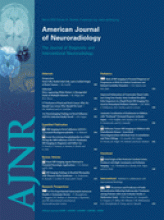Article Figures & Data
Tables
- Table 1:
Qureshi grading scheme for stratification of patients with acute ischemic stroke based on initial site of occlusion and collateral supply
Grade Qureshi Grading Scheme 0 No occlusion 1 MCA occlusion (M3 segment), ACA occlusion (A2 or distal segments), 1 BA/VA branch occlusion 2 MCA occlusion (M2 segment), ACA occlusion (A1 or A2 segments), ≥2 BA/VA branch occlusions 3 MCA occlusion (M1 segment) 3A Lenticulostriate arteries spared and/or leptomeningeal collaterals visualized 3B No sparing of lenticulostriate arteries or leptomeningeal collaterals visualized 4 ICA occlusion (collaterals present), BA occlusion (partial filling direct or via collaterals) 4A Collaterals fill MCA, anterograde fillinga 4B Collaterals fill ACA, retrograde fillinga 5 ICA occlusion (no collaterals), BA occlusion (complete) Note:—The interobserver variability and correlation with recanalization and short-term favorable outcome and mortality have been previously described in patients with acute ischemic stroke undergoing intra-arterial thrombolysis.22,23
a The predominant pattern of filling.
Variable OR (95% CI) P Value for Difference P Value for Trend Age strata N/A ≤70 years Reference >70 years 4.4 (1.9–10.5) .0008 NIHSS score strata <.0001 0–9 Reference 10–19 3.8 (1.7–8.4) .001 ≥20 64.4 (28.8–144.4) <.0001 Time to treatment strata .38 ≤3 hours Reference 3–6 hours 2.5 (1.3–4.8) .0049 >6 hours 1.3 (0.8–2.2) .27 Occlusion severity strata (Qureshi: grade) N/A Mild (grade 0–2) Reference Severe (grade 3–5) 0.4 (0.1–2.6) .37












